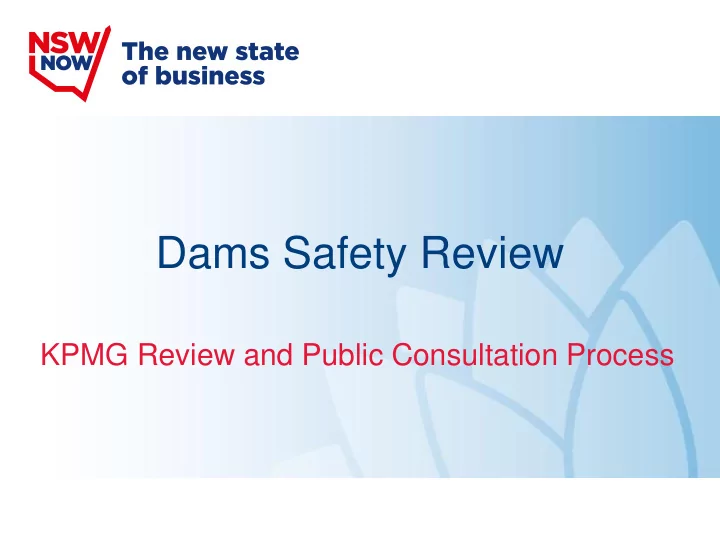

Dams Safety Review KPMG Review and Public Consultation Process
Why Review? The DSC is a statutory authority constituted under the NSW Dams Safety Act 1978 to ensure the safety of dams in NSW. From the NSW Commission of Audit’s Final Report on Expenditure: “ The standards set by the Dams Safety Committee appear to be achieving small risk reductions for major costs. This needs examination.” Recommendation: The Commission recommends that an independent review be conducted of the standards set by the Dam Safety Committee following a through risk and cost assessment. The Act has not been reviewed since it was introduced in 1978.
Components of the Review Stage one - Independent consultant review. - KPMG with engineering support from GHD. - Direct stakeholder consultation only. - Regulatory review based on best practice. Stage two - Public consultation broadly outlining possible reforms to the dam safety regime. - Undertaken by Trade & Investment. Stage three - Implementation. - Likely to be Act amendments.
Terms of Reference The Terms of Reference are: a) Clarify the objectives of the Dams Safety Act 1978 and the ‘market failures’ being addressed. b) Consider alternative means for achieving the objectives of the legislation and identify if and where these objectives can only be achieved by regulatory intervention. c) Consider the most effective methods of ensuring public safety at large (prescribed) dams while retaining as much functionality as practical. d) Consider the Risk Management Policy Framework for Dam Safety 2006 and whether amendment of this policy is warranted. e) Assess and balance the costs and benefits to the community and Government, including risk implications of proposed retained or new interventions. f) Make recommendations to the Minister for Primary Industries on possible amendments to the Act and Dams Safety Committee constitution and role. g) Consider how advice from the Dams Safety Committee can be better integrated with the development assessment process, particularly for state significant development.
Terms of Reference In undertaking this analysis, the review will: h) Consider the role and performance of equivalent statutory arrangements in other jurisdictions. i) Consider the safety cost/benefit trade-offs that are made in other industries. j) Report on the potential impact of extractive (mining) activities on dam safety. k) Consult with the Dams Safety Committee, dam managers (including State Water Corporation, Sydney Catchment Authority, Sydney Water and Hunter Water) and other relevant water managers in NSW. l) Consult with the Department of Finance and Services, the State Emergency Service, WorkCover, NSW Trade and Investment (Resources and Energy), NSW Department of Primary Industries (Fisheries) and any other NSW Government agency relevant to dam safety.
Stage One - KPMG Findings The existing regulatory framework is resulting in levels of capital investment greater than would be considered optimal. Issues with the current regulatory framework identified by KPMG are: – the Act does not have clearly stated objectives; – the DSC has developed a primary focus on engineering solutions rather than on a broader range of risk reduction strategies; – there is only a limited focus on applying benefit cost analysis to identify the most efficient risk reduction options; – there is lack of transparency for dam owners in regard to determinations by the DSC on reducing the risk of dam failure to "as low as reasonably practicable"; – the DSC in part comprises the same dam owners that are being regulated, creating real or perceived conflicts of interest; and – funding of the DSC should change from being mainly sourced from Government and in-kind support from members to being fully funded by the owners of regulated dams.
KPMG Key Recommendations To reduce the scope for over-investment, KPMG suggest: broadening the scope of the Act to require consideration of the full range of alternative risk reduction strategies beyond engineering solutions; and Implementing rigorous cost benefit analysis. KPMG suggest the dam safety regulator: be independent of the businesses it regulates; be comprised of representatives of relevant government agencies as well as independent skill based members with expertise in areas such as engineering, public safety risk management and benefit cost analysis; and be fully funded by those who create the need for dam safety regulation, which is all owners of prescribed dams.
KPMG Key Recommendations Develop a systematic and proactive approach to inform dam owners of potential developments downstream from their dams and engaging them early in the development approval process.
Stage Two – Public Consultation Release of Consultation Paper and KPMG Report. Broad reform options consistent with the KPMG findings are outlined in the Consultation Paper. Submissions are now being sought. Submissions are not limited and can cover any or all of the points raised in the Consultation Paper, or additional issues.
Consultation Submissions may be lodged by email or by post. http://www.dpi.nsw.gov.au/aboutus/about/legislation- acts/review/dams-safety Please provide your submission by 31 October to one of the addresses below: Email to: damsafety.review@industry.nsw.gov.au Post to: Dams Safety Review NSW Trade and Investment GPO Box 5477 Sydney NSW 2001
Questions Iowa USA - Lake Delhi Dam failure 2010
Recommend
More recommend